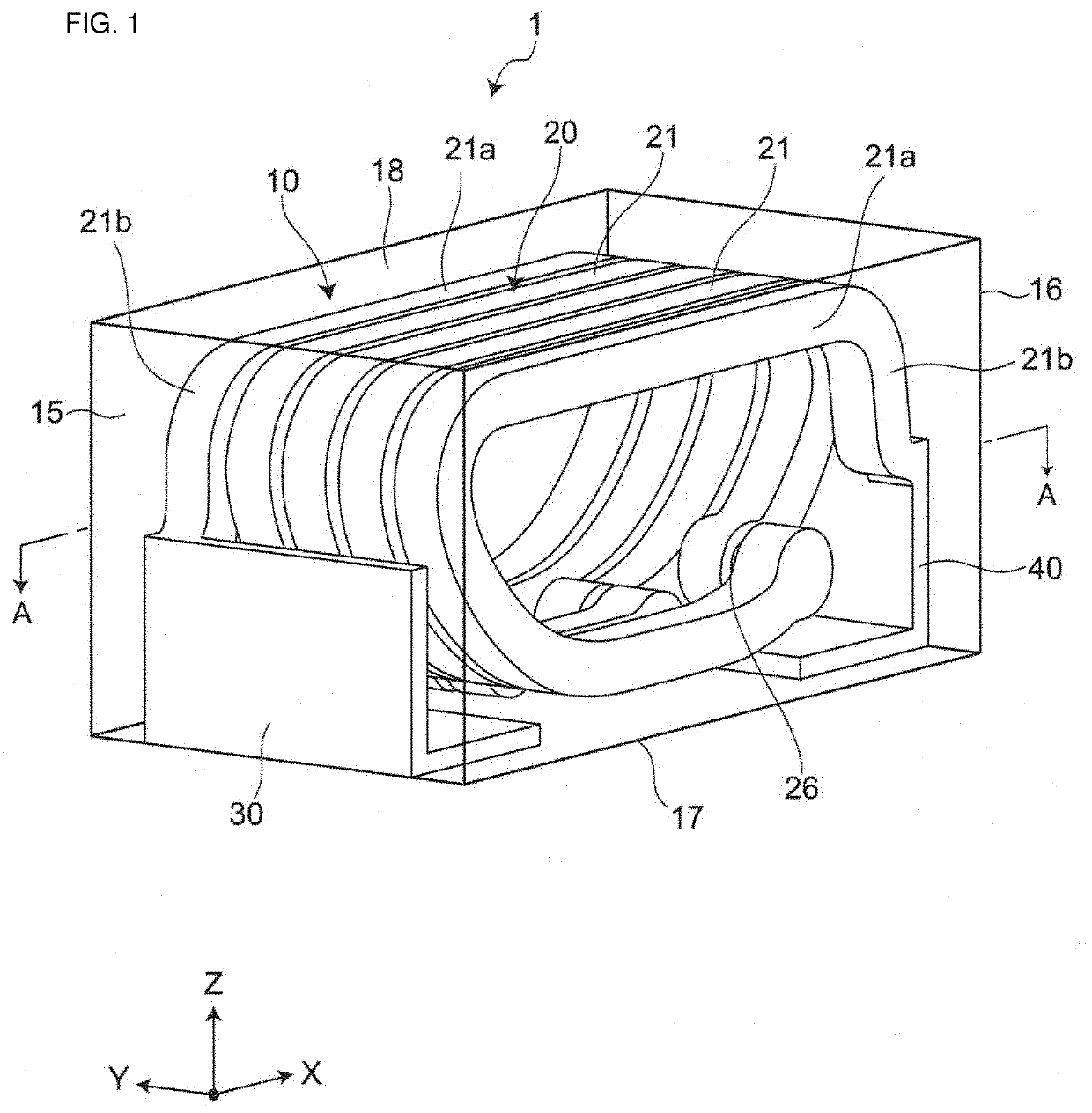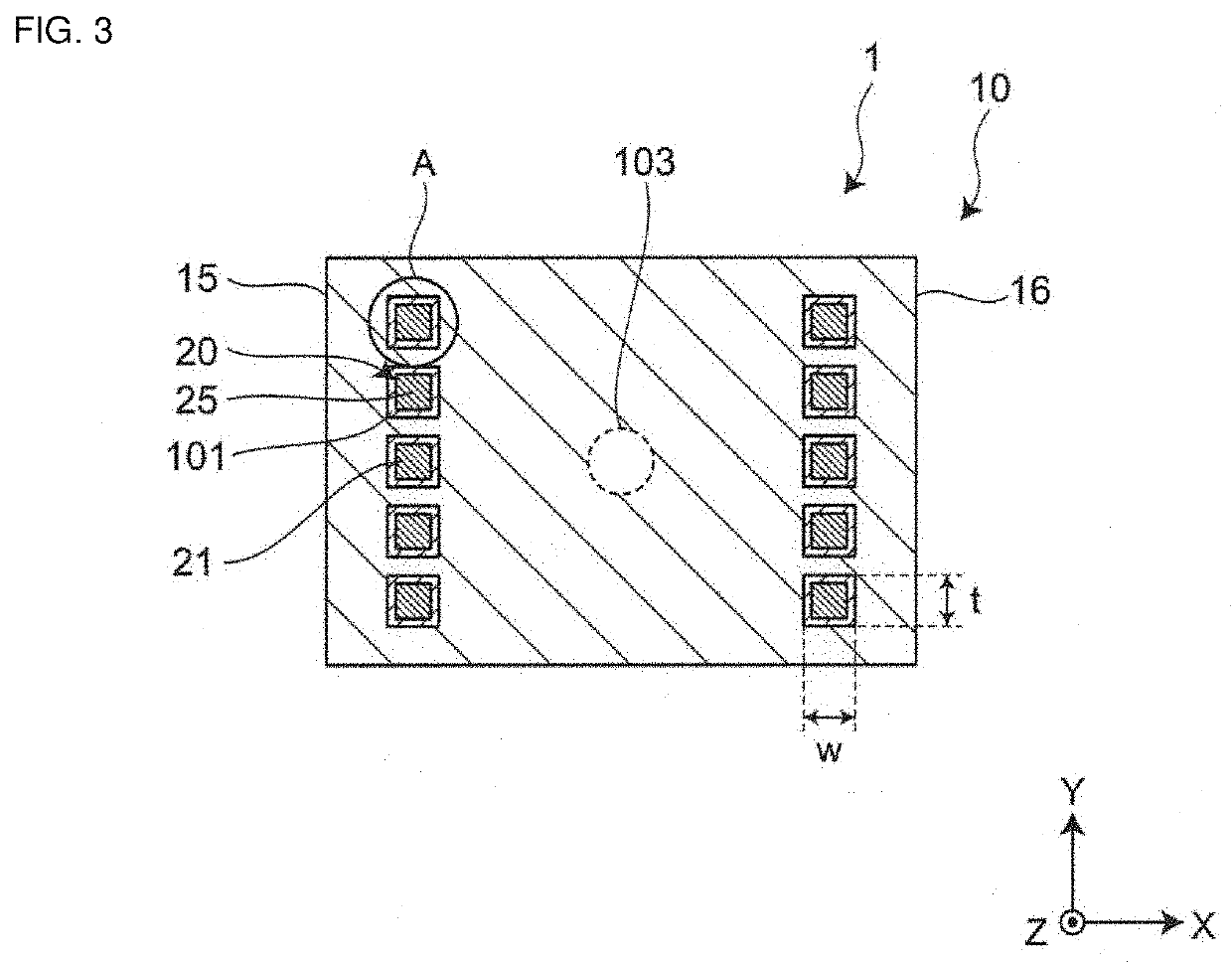Inductor component
- Summary
- Abstract
- Description
- Claims
- Application Information
AI Technical Summary
Benefits of technology
Problems solved by technology
Method used
Image
Examples
first embodiment
[0054]Configuration
[0055]FIG. 1 is a perspective view showing a first embodiment of an inductor component. FIG. 2 is an exploded perspective view showing the first embodiment of the inductor component. FIG. 3 is a sectional view cut along line A-A in FIG. 1. FIG. 4 is a magnified partial view of the diagram (diagram showing a magnified portion A) in FIG. 3.
[0056]As shown in FIG. 1 and FIG. 2, the inductor component 1 includes an element assembly 10, a coil 20 that is an inner electrode arranged in the element assembly 10, and a first outer electrode 30 and a second outer electrode 40 that are electrically coupled to the coil 20. In FIG. 1, the element assembly 10 is expressed as being transparent so that the internal structure (in particular, the structure of the coil 20) of the element assembly 10 is readily understood. Meanwhile, in FIG. 1, a filler-poor glass portion is omitted so that the internal structure of the element assembly 10 is readily understood.
[0057]The inductor comp...
example
[0120]The inductor component 1 of the example had a structure in which the insulating layers 11 provided with the coil conductor layer 25 were directly stacked.
[0121]Mother Multilayer Body Formation Step
[0122]An insulating paste layer was formed by repeating application of an insulating paste containing the borosilicate glass as a primary component by screen printing. The insulating paste layer was an outer-layer insulating layer located outside the coil conductor layer 25 in the stacking direction. The borosilicate glass contained B, Si, O, and K.
[0123]The photosensitive conductor paste layer was formed on the outer-layer insulating layer by coating. The coil conductor layer 25 and the outer conductor layer were formed by a photolithography step. Specifically, the photosensitive conductor paste layer was formed by applying the photosensitive conductor paste containing Ag as a metal primary component by screen printing. The photosensitive conductor paste layer was irradiated with ul...
second embodiment
[0138]FIG. 8 is a sectional view showing a second embodiment of an inductor component 1A. The second embodiment is different from the first embodiment in that the thickness of the filler-poor glass portion 101 near to the outer edge of the coil conductor layer 25 is different from the thickness near to the inner edge of the coil conductor layer 25. The configuration including this difference will be described below. In the second embodiment, the same references as in the first embodiment indicate the same configurations as in the first embodiment and explanations thereof are omitted.
[0139]As shown in FIG. 8, the inductor component 1A according to the second embodiment includes a first filler-poor glass portion 101A and a second filler-poor glass portion 101B. In a plane perpendicular to the winding axis of the coil 20, the first filler-poor glass portion 101A is in contact with the outer edge of the coil wiring line 21, and the second filler-poor glass portion 101B is in contact wit...
PUM
| Property | Measurement | Unit |
|---|---|---|
| Fraction | aaaaa | aaaaa |
| Thickness | aaaaa | aaaaa |
| Content | aaaaa | aaaaa |
Abstract
Description
Claims
Application Information
 Login to View More
Login to View More - R&D
- Intellectual Property
- Life Sciences
- Materials
- Tech Scout
- Unparalleled Data Quality
- Higher Quality Content
- 60% Fewer Hallucinations
Browse by: Latest US Patents, China's latest patents, Technical Efficacy Thesaurus, Application Domain, Technology Topic, Popular Technical Reports.
© 2025 PatSnap. All rights reserved.Legal|Privacy policy|Modern Slavery Act Transparency Statement|Sitemap|About US| Contact US: help@patsnap.com



